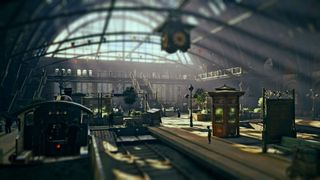The city of London in Assassin's Creed Syndicate


In Why I Love, PC Gamer writers pick an aspect of PC gaming that they love and write about why it's brilliant. Today Ben goes sightseeing in ye olde London.
The likes of Renaissance Italy and America in the throes of revolution are rich, textured periods in which to set a game, sure, but they’re almost fantasy locales at this point, as culturally removed from today as a time capsule buried under 40ft of dirt. Syndicate’s 1860s London setting is closer to a faint footprint cleft by identifiable traces of contemporary life.
Travelling from the outskirts to the centre reveals trickle-down improvements to living standards. It’s like a big modernity bomb exploded in the centre of London and gave rise to architectural wonders. Then its less potent shockwaves spread to surrounding boroughs, where residents still live in wooden shacks. That’s surprisingly similar to how my real world commutes go: you pass Victorian-era brick houses, albeit now smothered in graffiti, en route to 21st century networks of concrete and glass. There are echoes of the past everywhere you look.

And Syndicate’s past coincides with uproarious industrial-powered transformation. This is a time when steam could come out of buildings even if they weren’t on fire. A time when walking along roads wouldn’t make your feet muddy, and crossing them involved looking both ways. It doesn’t feel specifically built for a hooded man with grabby hands to navigate conveniently, but an imposing sprawl with multi-lane boulevards and towering buildings. Ubisoft designed your character to cope with the playing space, rather than the other way around. It’s a global city, not a film set.
Take, for example, your new rope launcher given to you by telephone inventor and parkour enthusiast Alexander Graham Bell. You not only fire it upwards to cut the hassle out of climbing spires (I’ve been climbing Assassin’s Creed’s spires since 2007 and it’s boring now), but for the first time, launch it sideways and latch onto ledges, walls, and balconies a block away. Rapid lateral movement is entirely necessary given London’s increased expanse.
There are also also Fast Moving Things. Horses, carriages, and steam trains were advances in a travel sector whose only innovation at that point was shoes, and they were again necessary for a capital which, if you crossed on foot, would take years off your life. My favourite byproduct of this new world is the addition of a stumbling animation when you jump from a speeding object. That’s never been needed before, because things didn’t used to be fast. Now things are fast. Technology.

That’s to say nothing of the life within this city. I overhear dozens of discussions while wandering about: people talking the British Empire’s foreign policy in Africa and Australia over a newspaper, or the latest fashion trends, or women’s rights in cases of running for parliament and divorcing spouses, or universal suffrage. They paint a vivid picture of a particular time and place, allowing you to tune into different frequencies of the national conversation.
Syndicate’s London is a London on the cusp of modernity. I love tracing lines of the past to their contemporary solutions - here’s what telephone poles looked liked before they evolved into metallic eyesores, or that’s how trains worked when commuters didn’t need to be packed into plastic grey tubes. I can’t identify with Native Americans crossing the wilderness or pirates sailing the Caribbean, but I can with a playable character who overhears inane conversations at bus stations, because that happens a lot in my life. That’s why, for me, this staggering setting is Assassin’s Creed’s most striking yet.
PC Gamer Newsletter
Sign up to get the best content of the week, and great gaming deals, as picked by the editors.
Most Popular

